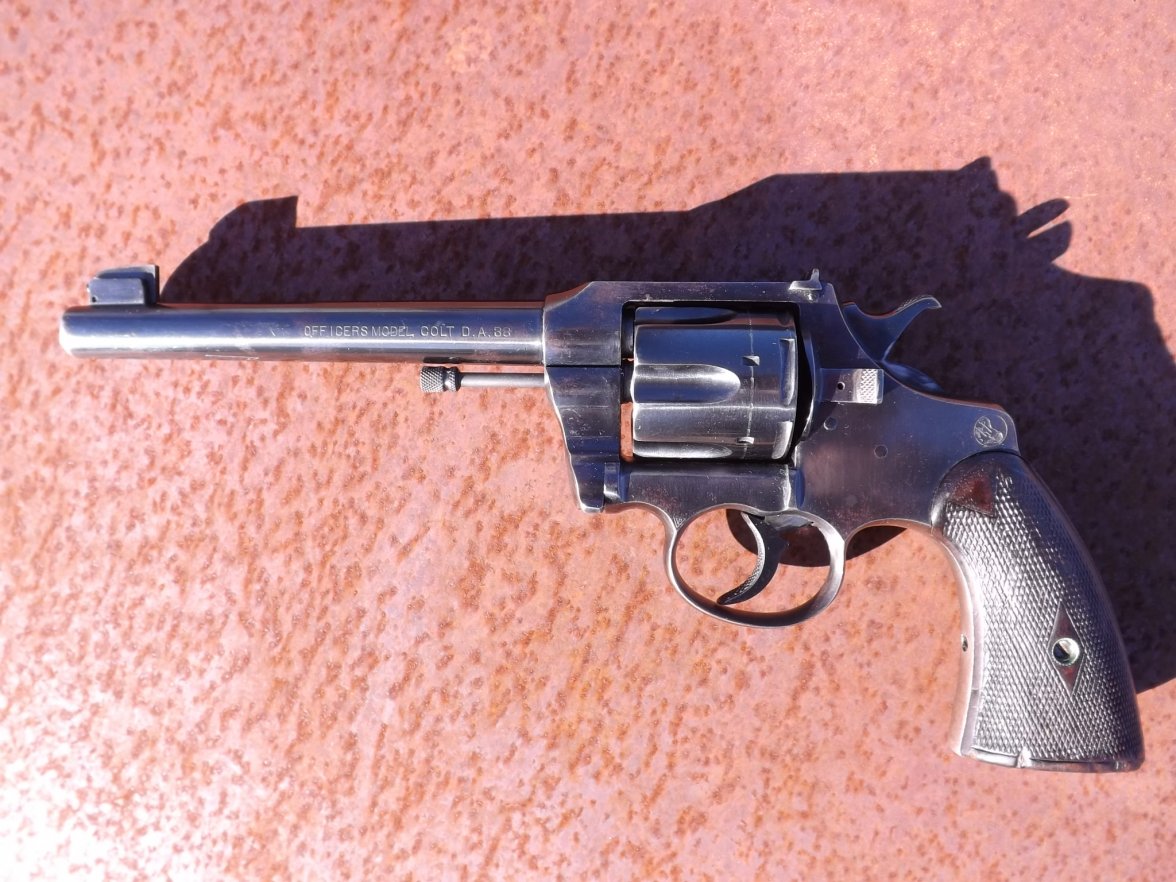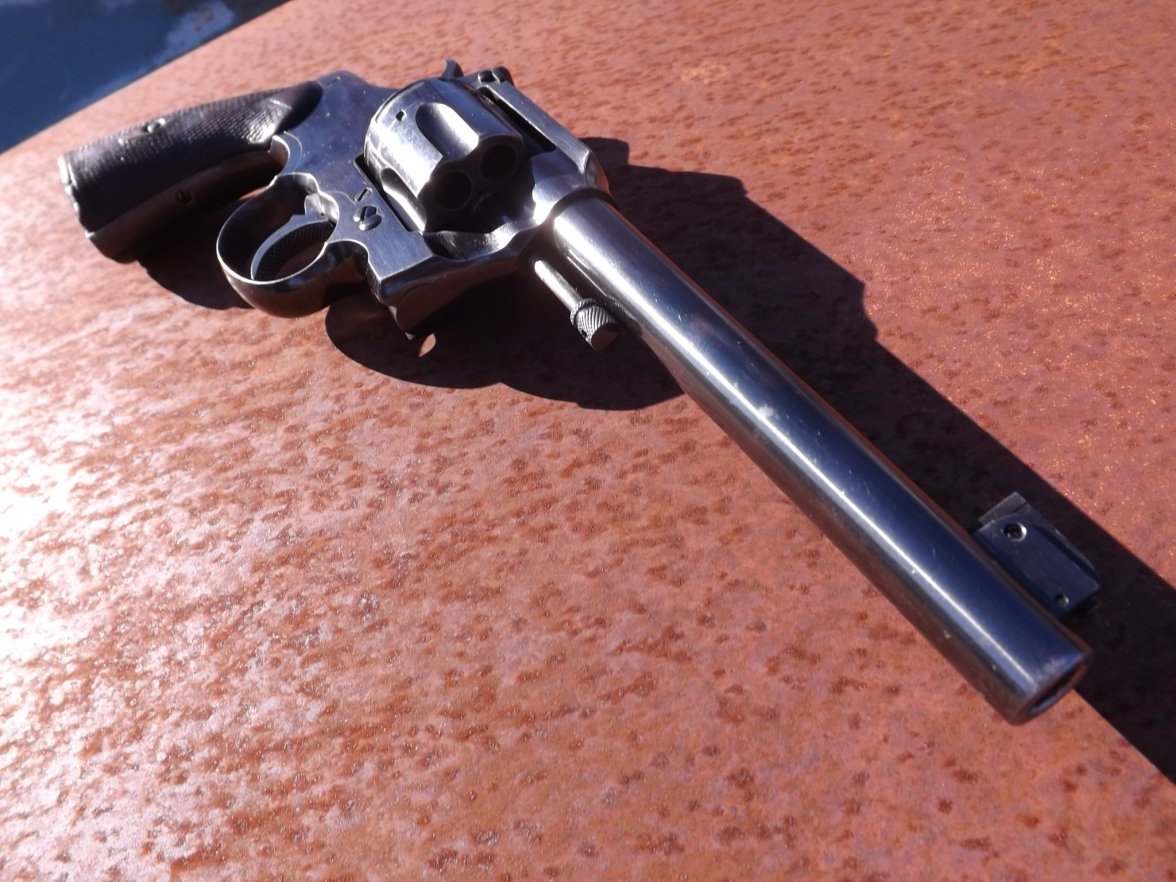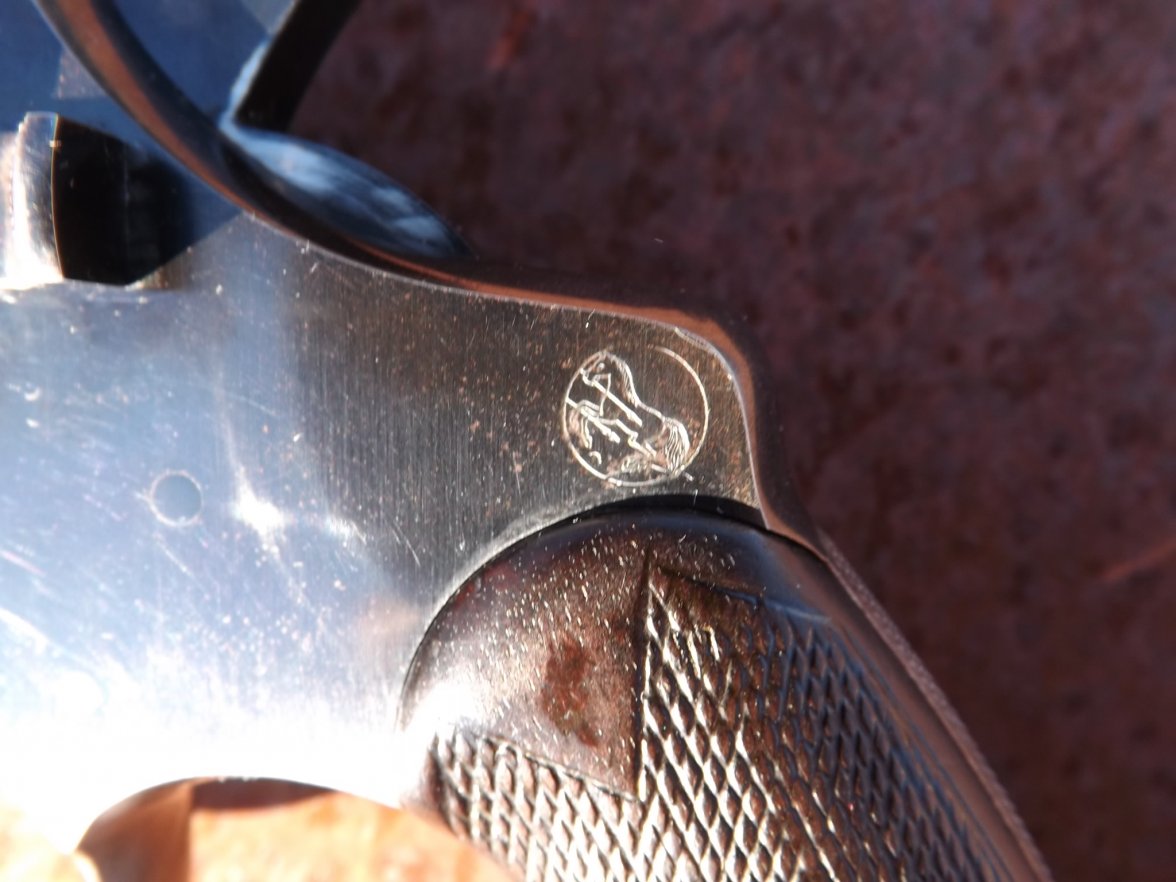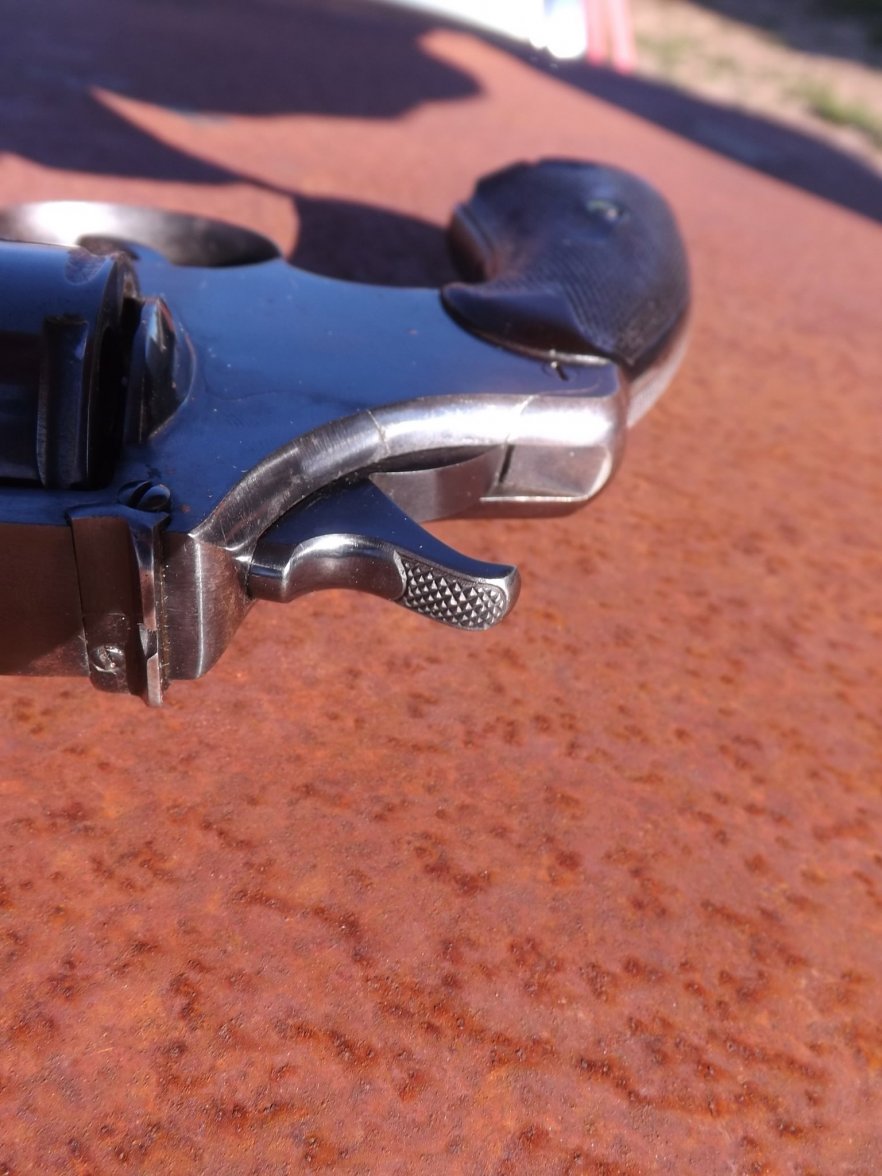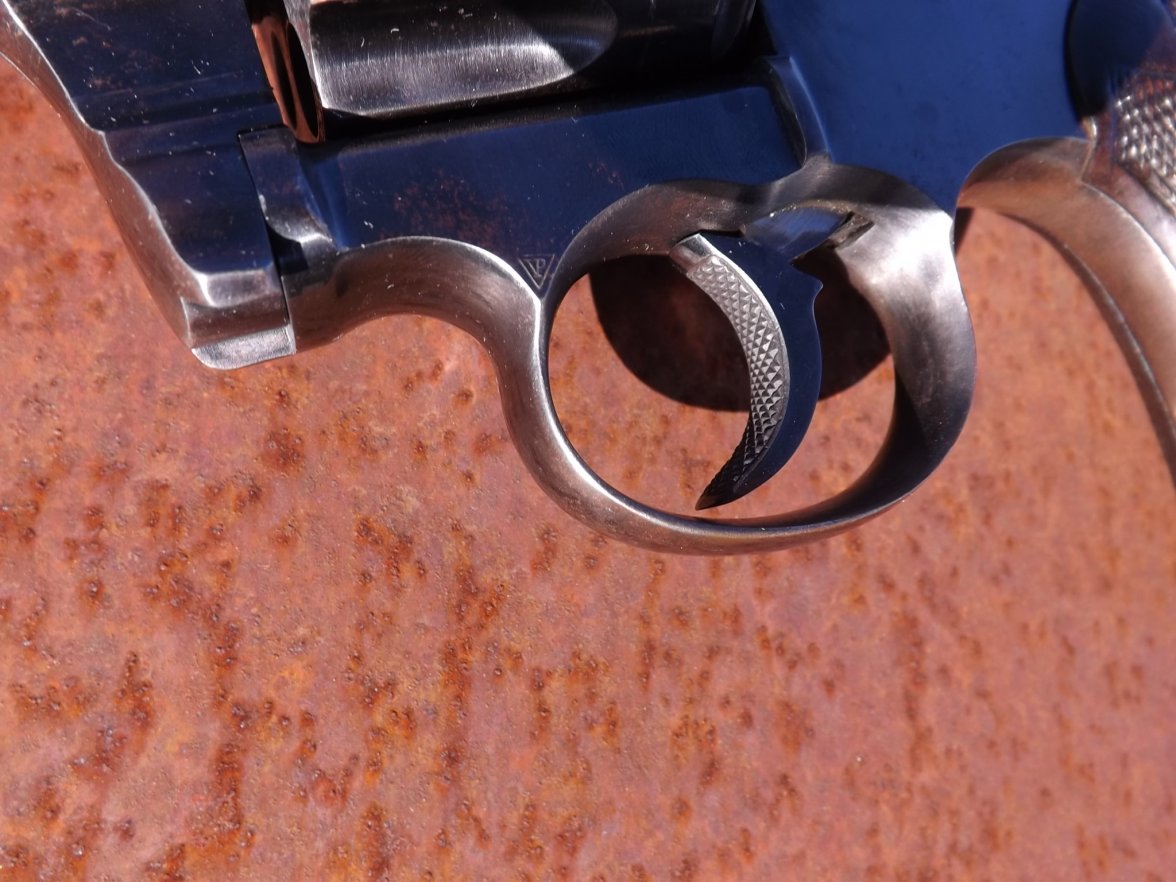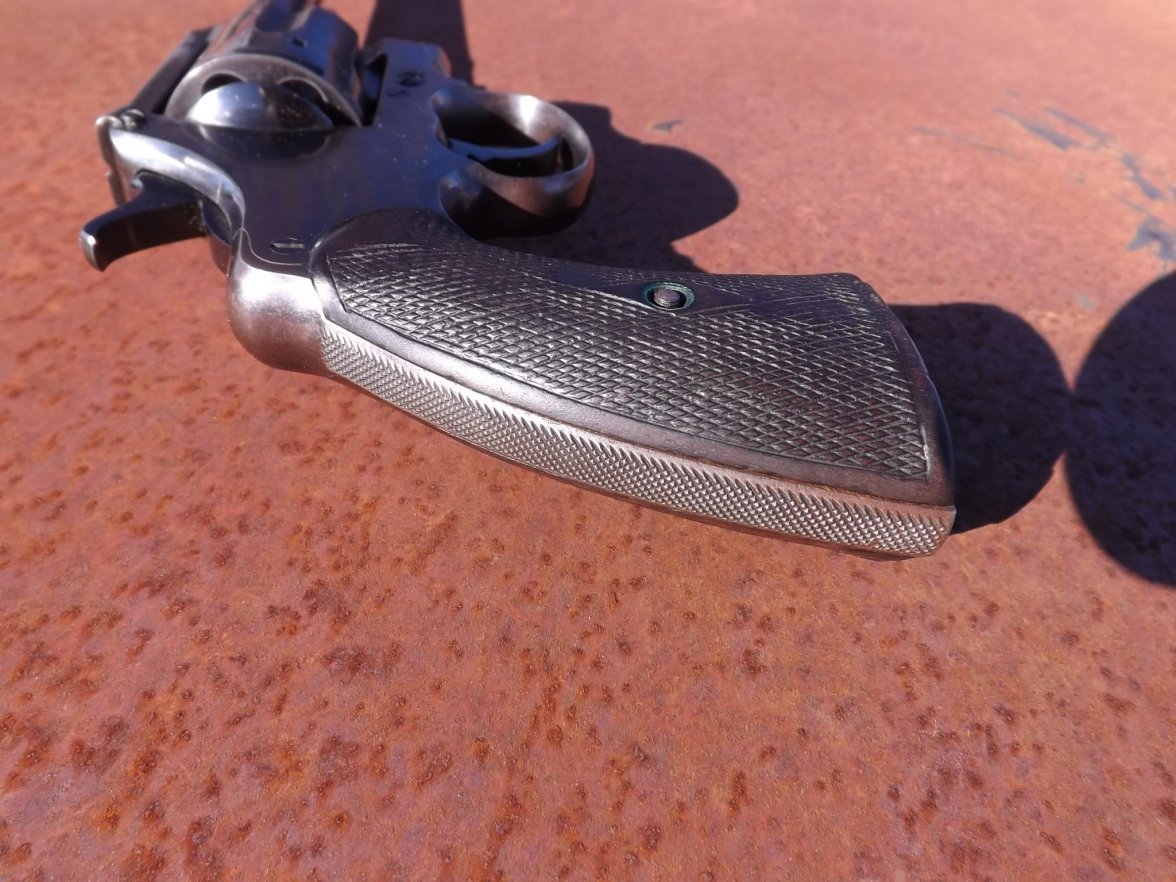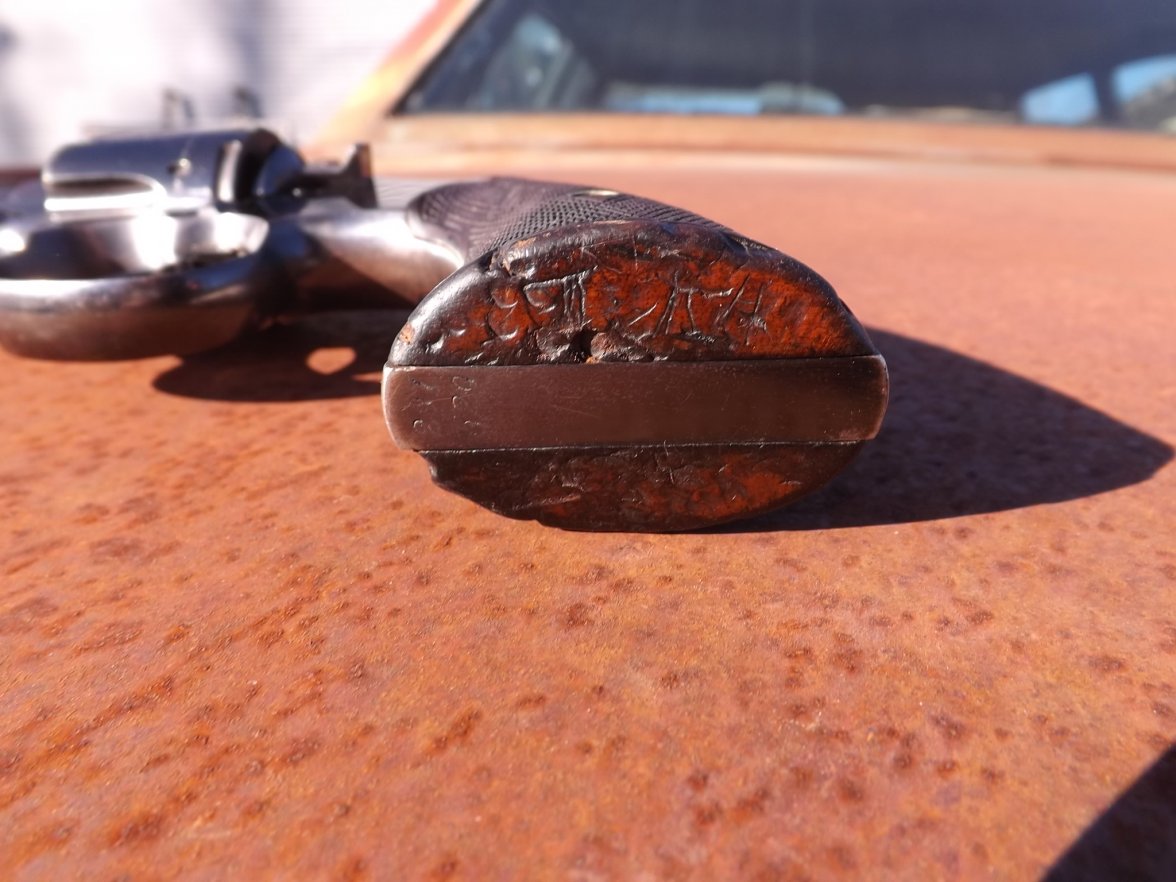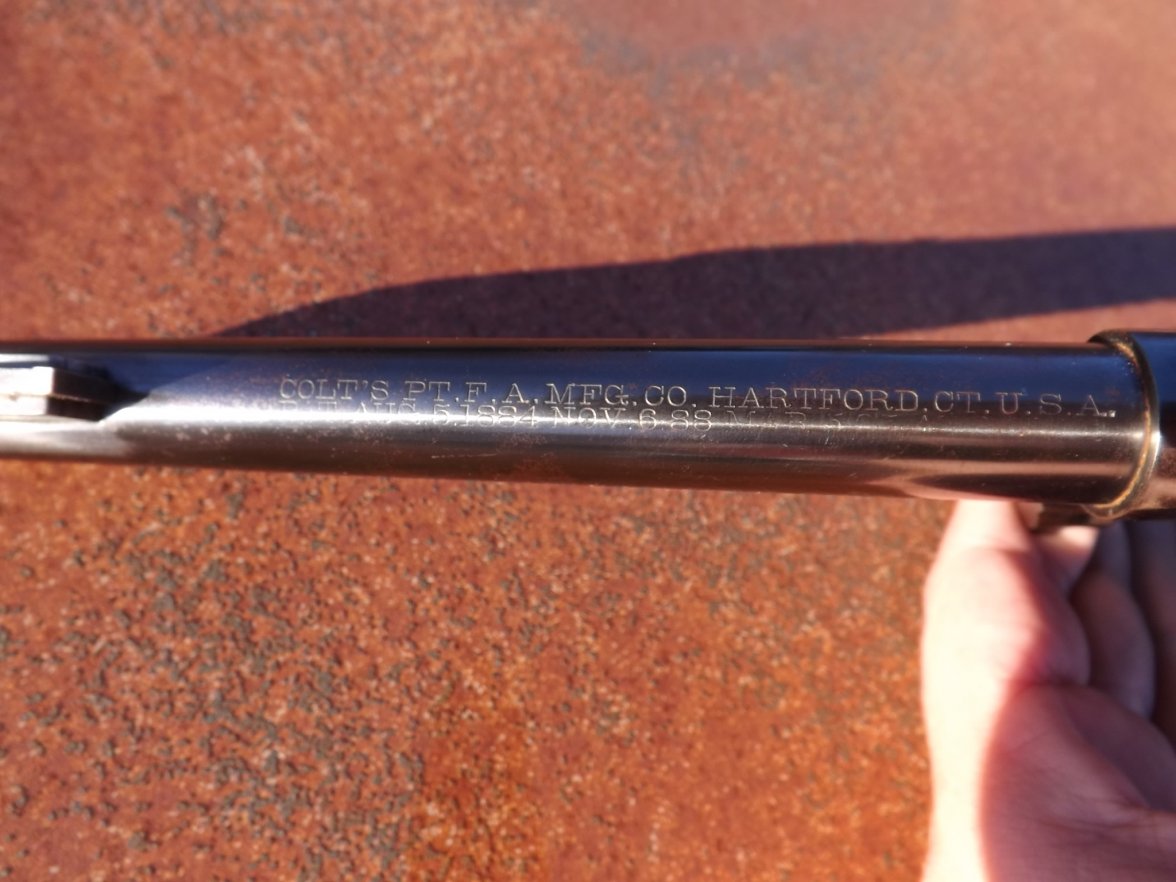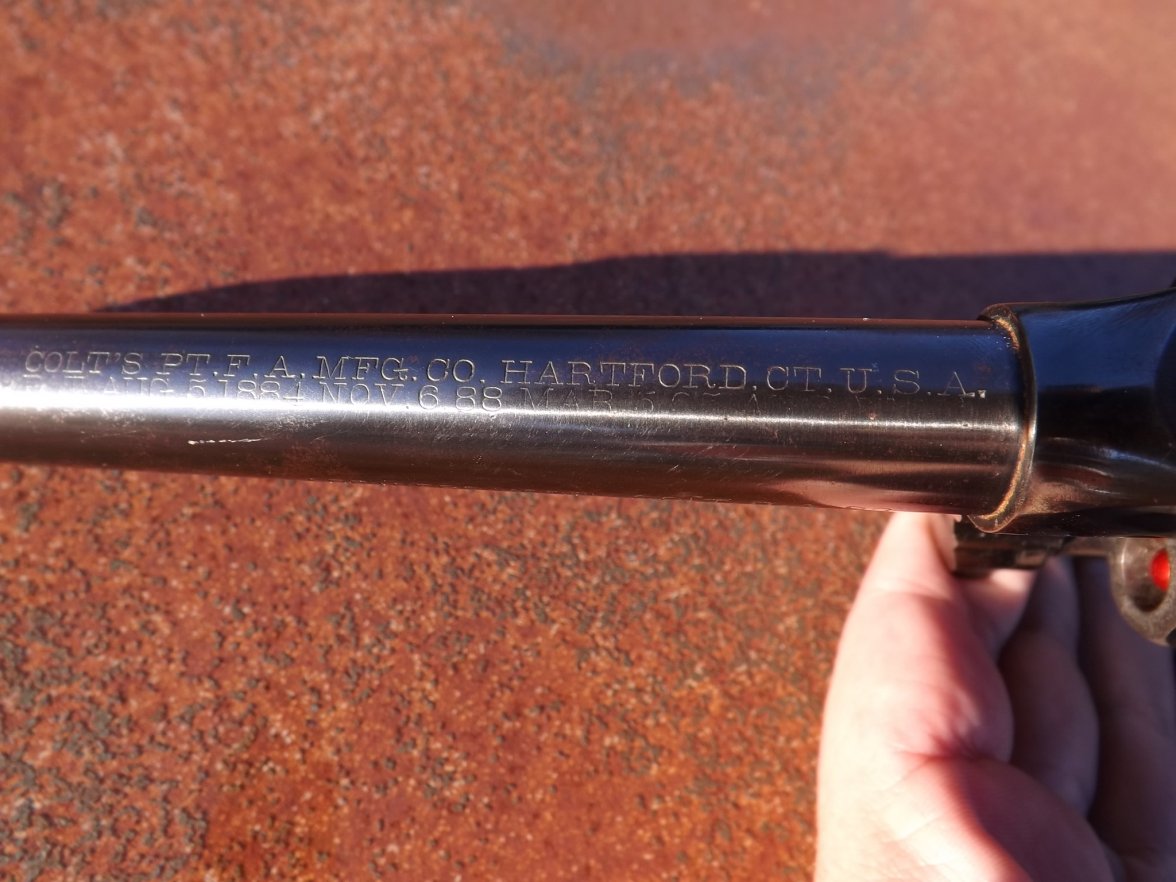So... any of our members here have an interest in firearms?
Professor
·I had a alloy frame Airweight Model 37 years ago. It had been found deep in the mud of a lake bottom.
It was an early model with alloy cylinder, only the barrel and internal parts were steel.
It had been plated. Apparently they chromed the barrel and nickel plated the rest.
Chemicals in that badly polluted lake had turned the nickel into a thick crust with consistency of dried clay. You could scrape that crust off with a thumbnail. under the crust the alloy was rough. The barrel was still in good shape and the inside of the chambers were still slick. The springs had rusted away completely but the other parts were just pitted a bit.
Not having the equipment or knowledge to re-plate it I baked on a painted finish that held up fairly well on the alloy parts but peeled off the chromed steel barrel fairly quickly.
These days you can get purpose formulated baking lacquer to refinish guns.
A less than cherry revolver intended for rough outdoor carry would benefit from such a finish, and it wouldn't be hard to touch it up now and then.
It was an early model with alloy cylinder, only the barrel and internal parts were steel.
It had been plated. Apparently they chromed the barrel and nickel plated the rest.
Chemicals in that badly polluted lake had turned the nickel into a thick crust with consistency of dried clay. You could scrape that crust off with a thumbnail. under the crust the alloy was rough. The barrel was still in good shape and the inside of the chambers were still slick. The springs had rusted away completely but the other parts were just pitted a bit.
Not having the equipment or knowledge to re-plate it I baked on a painted finish that held up fairly well on the alloy parts but peeled off the chromed steel barrel fairly quickly.
These days you can get purpose formulated baking lacquer to refinish guns.
A less than cherry revolver intended for rough outdoor carry would benefit from such a finish, and it wouldn't be hard to touch it up now and then.
MikiJ
·Hard to beat a Stainless Steel Wheel-gun for "rough outdoor carry".
Professor
·Hard to beat a Stainless Steel Wheel-gun for "rough outdoor carry".
If you already have a stainless gun you aren't likely to have a gun with badly pitted surfaces you want to refinish. Though in reality most stainless alloys are resistant to corrosion rather than corrosion proof and I've seen a few that showed some surface discoloration or corrosion from contact with sweaty hands or chemicals.
MikiJ
·True enough though even a brushed or matt finish stainless can be a bit too easily visible under some conditions.
If you already have a stainless gun you aren't likely to have a gun with badly pitted surfaces you want to refinish. Though in reality most stainless alloys are resistant to corrosion rather than corrosion proof and I've seen a few that showed some surface discoloration or corrosion from contact with sweaty hands or chemicals.
Waltesefalcon
·Voere, it's looking pretty good so far. I look forward to seeing the finished product.
Professor
·Maybe because I thoroughly clean my pistols everytime I take them in the field with me, I've never had that problem.
I clean mine throughly as well. I own no Stainless guns at this time yet don't have any that rusted while I owned them, other than a BP C&B revolver I used straight Balistol on rather than Balistol with water with a WD40 soaking afterwards and left for three months without checking on it. Rust and pitting formed in the corners of the lands, not on any external surfaces.
I have run across a number of Stainless Revolvers with serious surface pitting. They weren't given proper cleaning every time they left the house, and likely spent years in holsters, glove boxes or under car seats. Some may have spent days in a damp holster on hunting trips during damp weather.
A nickeled revolver I saw once had lost much of its plating after being doused with Hoppes No.9 and left in a real fleece lined gun case. Apparently many copper solvents will also dissolve nickel plating. later I read that natural wool fleece may have lanolin, which breaks down oils, in it and in combination with solvents can speed the destruction of nickel plating.
Modern preservative oils can prevent most any corrosion if used properly. Mineral/petroleum based oils, if applied too liberally, can attack naturally finished wooden grip panels or stocks causing "oil Perishing" of wood.
noelekal
··Home For Wayward WatchesWryfox
·Waltesefalcon
·This was waiting for me today. A Colt Officer's Model made in 1907. The action has weak lock up which I will look into this weekend and it was reblued at some point in its life. On the plus side though the checkering on the hammer, trigger, and backstrap is outstanding, both the front and rear sights still adjust as they should, and the trigger is amazingly crisp and light.
noelekal
··Home For Wayward WatchesYea waltesefalcon!
The markings are awfully crisp for a reblue. I guess it's one of those things one has to experience in person to recognize the refinish. Sure do like the detail of the checkering on the steel, a nice exhibition of the extra that when into the workmanship of the target models of the day. Those stocks are to die for and one of my favorite classic styles of walnut stocks on premium revolvers of bygone times.
It'd be so entertaining to spend an afternoon striving to shoot tight groups with wadcutter loads in your new Colt.
The markings are awfully crisp for a reblue. I guess it's one of those things one has to experience in person to recognize the refinish. Sure do like the detail of the checkering on the steel, a nice exhibition of the extra that when into the workmanship of the target models of the day. Those stocks are to die for and one of my favorite classic styles of walnut stocks on premium revolvers of bygone times.
It'd be so entertaining to spend an afternoon striving to shoot tight groups with wadcutter loads in your new Colt.
Waltesefalcon
·Noelekal, There are two things that are circumstantial on their own but together make me tend to believe that it has been reblued. One is the condition of the stocks, they are very beaten up and worn while the gun shows very little wear of any sort. Two is something I didn't provide a photo of in my previous post, the roll mark on the barrel looks to have been heavily polished. Here you can see the last patent date is nearly non-existent. There is the chance that I am being paranoid and/or overly critical of the gun. The bore is shiny with sharp rifling still and, as previously stated the action is rather light and crisp, so I don't think it has been used too much. This is my first Army/Navy model Colt so I am not sure that the weak lock-up is unique to mine or is a ubiquitous flaw of this design. I'm assured that it is chambered i9n .38 spl, but with it being old and of a design that is generally considered to be weak I think that I'll cut down some of my .38 spl. brass and make some .38LC loads for it before I go shooting with it. I am hoping for good results with it.
Edited:
Professor
·I've been told that you can fire .38 Special wadcutters in the .38 long chambers without any problems and fair accuracy due to the hollow base lead bullet. This has been done with older Colt Navy conversions.
Mac5
·I own three. Waltham PPQ 9mm handgun and two shotguns. Winchester 20 gauge I got from Dad when I was 12 or 13. 2nd one is a 12 gauge Beretta that my Dad gave to me.
Waltesefalcon
·I've been told that you can fire .38 Special wadcutters in the .38 long chambers without any problems and fair accuracy due to the hollow base lead bullet. This has been done with older Colt Navy conversions.
I'm only going to be cutting some brass down for this one so I can visually distinguish my light loads I'll be loading for this gun from my standard .38spl loads. I use between 5 and 5.5 grains of unique (depending on the bullet) in a typical .38 spl load, I think I'll be going with about a 3 grain load for this old timer just to keep the wear and tear down on the lock mechanism.
noelekal
··Home For Wayward WatchesWaltesefalcon;
Yeah, maybe so on the refinish. Looking at the markings on top of the barrel I can see your point. Those markings on the side are awfully crisp though. Do you think that the top roll mark is the result of a weak strike? If it is a reblue then it's an old reblue for it has a dab of blue wear and a soft pleasing patina. It is curious how the refinisher would have "gotten a little too happy" with his polishing wheel on portions of the roll markings and yet left others so crisp and sharp. Your photographs would seem to show a bit of brushed surface finishes and I'm guessing that's not original. Could be where someone wiped it a bit enthusiastically with some rough or dirty cloth.
This is only a guess, but I'm wondering if those stocks did not originally come on that revolver. Those stocks were on a revolver used to hammer something with its butt. It is telling that your revolver's grip frame butt shows no corresponding marring of its steel surfaces. I've inspected other revolvers over the years that had been used as hammers and if the wood bore evidence of it then so did the metal. At any rate I love ... love ... love the styling of those target Colt stocks of that time period and those are correct style.
There are some other Officers Models First Issues scattered within this Google Images search for them. Of course other later models are also included in the page.
https://www.google.com/search?client=firefox-b-1&biw=1254&bih=845&tbm=isch&sa=1&ei=KURJXNm9LtXB7gKulquABg&q=Colt Officers Model first issue&oq=Colt Officers Model first issue&gs_l=img.3...42179.42750..43719...0.0..1.350.835.0j4j0j1......0....1..gws-wiz-img.hlSobjKU4U4#imgrc=_
Sam Lisker's site doesn't have many Colt revolvers of that era pictured and no Officers Models. Here's one about a decade older than yours. It's the standard model and not a target model but blue finish and markings would be similar.
http://www.coltautos.com/DA/NewArmyNavy/newarmynavyci_86905.htm
I've prepared and fired a goodly amount of hand loaded .38 Long Colt ammunition over the years for this Colt Model 1901, a U. S. military contract version of the Colt New Army, my first ever Colt revolver and owned since the late 1970s.

The .38 Long Colt is dimensionally similar the .38 Special excepting for length. Colt .38 Long Colt chambers are bored through with no shoulders so it is possible to use the longer .38 Special cases for the loads as long as the bullets don't exceed .38 Long Colt maximum overall cartridge length. For that matter it is conceivable that .357 Magnum cases could fit though I can't imagine any factory .357 Magnum cartridge that would be short enough to chamber in the .38 Long Colt cylinder without the bullet's nose protruding from the front of the cylinder. Of course that condition would tie up the revolver, rendering the cylinder unable to close. Assuming one persisted in chambering some .357 Magnum cartridge, perhaps with a short light bullet, into a .38 Long Colt revolver and attempted to fire it then he will have created a pretty fair imitation of a grenade. A heavy .38 Special load such as a factory +P load or a hot hand load would like grenade the .38 Long Colt revolver as well. A standard velocity .38 Special cartridge that would chamber completely within the .38 Long Colt cylinder probably wouldn't do the revolver any good, making it loosen up at best or, at worst scattering bits of revolver to the four winds.

A circa 1900 Franfort Arsenal military .38 Long Colt cartridge with its 150 grain lead round nose bullet shown with a Winchester Western +P 158 grain lead semi-wadcutter .38 Special cartridge.
I have used up to 4.0 grains of Unique in .38 Long Colt cartridge cases under 148 grain to 158 grain bullets. Didn't find it particularly satisfying as Unique burns "dirty" with much smoke and with residue remaining in the bore. Velocities are erratic, given to large extreme spreads. It seems to me that Unique burns cleaner and gives more consistent velocities at moderate to heavy charge weights. I'm unwilling to use moderate to heavy charge weights of Unique or any other powder in the old wheezer Colts of that era.
Being an old geezer, Unique is my very favorite handgun powder of all. I like quite a few others, but its ... well ... unique.
Early on I assumed much and attempted to make up .38 Long Colt ammunition by using standard .358" diameter lead bullets designed for the .38 Special. Took them to the range and fired them at 15 yards, only to obtain 12-inch "groups." Some keyholed.
"Slugged" the bore in order to obtain bore diameter measurements and found that my .38 Long Colt revolver's bore was .362" in diameter. An expedient switch to the .38 Special 148 grain hollow base wadcutter gave perfect satisfaction. The hollow base of the .358" diameter target bullet will obturate well enough to fit the .362 bore and give quite good accuracy. The same 2.8 grain charge of Bulls-Eye with which I enjoy loading .38 Special target ammunition when using the 148 grain HBWC gives great performance with this same bullet in the .38 Long Colt. Velocities are in the very low 700 fps range.
It is said that the .38 revolvers Colt produced after 1903 all came with .357" diameter bores.
I confess to occasionally just using the untrimmed .38 Special case with the Bulls-Eye target load and the 148 grain HBWC in the .38 Long Colt. Not really authentic but the flush-seated wadcutter ammunition in .38 Special cases chambers with ample clearance in the .38 Long Colt chambers.
Yeah, maybe so on the refinish. Looking at the markings on top of the barrel I can see your point. Those markings on the side are awfully crisp though. Do you think that the top roll mark is the result of a weak strike? If it is a reblue then it's an old reblue for it has a dab of blue wear and a soft pleasing patina. It is curious how the refinisher would have "gotten a little too happy" with his polishing wheel on portions of the roll markings and yet left others so crisp and sharp. Your photographs would seem to show a bit of brushed surface finishes and I'm guessing that's not original. Could be where someone wiped it a bit enthusiastically with some rough or dirty cloth.
This is only a guess, but I'm wondering if those stocks did not originally come on that revolver. Those stocks were on a revolver used to hammer something with its butt. It is telling that your revolver's grip frame butt shows no corresponding marring of its steel surfaces. I've inspected other revolvers over the years that had been used as hammers and if the wood bore evidence of it then so did the metal. At any rate I love ... love ... love the styling of those target Colt stocks of that time period and those are correct style.
There are some other Officers Models First Issues scattered within this Google Images search for them. Of course other later models are also included in the page.
https://www.google.com/search?client=firefox-b-1&biw=1254&bih=845&tbm=isch&sa=1&ei=KURJXNm9LtXB7gKulquABg&q=Colt Officers Model first issue&oq=Colt Officers Model first issue&gs_l=img.3...42179.42750..43719...0.0..1.350.835.0j4j0j1......0....1..gws-wiz-img.hlSobjKU4U4#imgrc=_
Sam Lisker's site doesn't have many Colt revolvers of that era pictured and no Officers Models. Here's one about a decade older than yours. It's the standard model and not a target model but blue finish and markings would be similar.
http://www.coltautos.com/DA/NewArmyNavy/newarmynavyci_86905.htm
I've prepared and fired a goodly amount of hand loaded .38 Long Colt ammunition over the years for this Colt Model 1901, a U. S. military contract version of the Colt New Army, my first ever Colt revolver and owned since the late 1970s.

The .38 Long Colt is dimensionally similar the .38 Special excepting for length. Colt .38 Long Colt chambers are bored through with no shoulders so it is possible to use the longer .38 Special cases for the loads as long as the bullets don't exceed .38 Long Colt maximum overall cartridge length. For that matter it is conceivable that .357 Magnum cases could fit though I can't imagine any factory .357 Magnum cartridge that would be short enough to chamber in the .38 Long Colt cylinder without the bullet's nose protruding from the front of the cylinder. Of course that condition would tie up the revolver, rendering the cylinder unable to close. Assuming one persisted in chambering some .357 Magnum cartridge, perhaps with a short light bullet, into a .38 Long Colt revolver and attempted to fire it then he will have created a pretty fair imitation of a grenade. A heavy .38 Special load such as a factory +P load or a hot hand load would like grenade the .38 Long Colt revolver as well. A standard velocity .38 Special cartridge that would chamber completely within the .38 Long Colt cylinder probably wouldn't do the revolver any good, making it loosen up at best or, at worst scattering bits of revolver to the four winds.

A circa 1900 Franfort Arsenal military .38 Long Colt cartridge with its 150 grain lead round nose bullet shown with a Winchester Western +P 158 grain lead semi-wadcutter .38 Special cartridge.
I have used up to 4.0 grains of Unique in .38 Long Colt cartridge cases under 148 grain to 158 grain bullets. Didn't find it particularly satisfying as Unique burns "dirty" with much smoke and with residue remaining in the bore. Velocities are erratic, given to large extreme spreads. It seems to me that Unique burns cleaner and gives more consistent velocities at moderate to heavy charge weights. I'm unwilling to use moderate to heavy charge weights of Unique or any other powder in the old wheezer Colts of that era.
Being an old geezer, Unique is my very favorite handgun powder of all. I like quite a few others, but its ... well ... unique.
Early on I assumed much and attempted to make up .38 Long Colt ammunition by using standard .358" diameter lead bullets designed for the .38 Special. Took them to the range and fired them at 15 yards, only to obtain 12-inch "groups." Some keyholed.
"Slugged" the bore in order to obtain bore diameter measurements and found that my .38 Long Colt revolver's bore was .362" in diameter. An expedient switch to the .38 Special 148 grain hollow base wadcutter gave perfect satisfaction. The hollow base of the .358" diameter target bullet will obturate well enough to fit the .362 bore and give quite good accuracy. The same 2.8 grain charge of Bulls-Eye with which I enjoy loading .38 Special target ammunition when using the 148 grain HBWC gives great performance with this same bullet in the .38 Long Colt. Velocities are in the very low 700 fps range.
It is said that the .38 revolvers Colt produced after 1903 all came with .357" diameter bores.
I confess to occasionally just using the untrimmed .38 Special case with the Bulls-Eye target load and the 148 grain HBWC in the .38 Long Colt. Not really authentic but the flush-seated wadcutter ammunition in .38 Special cases chambers with ample clearance in the .38 Long Colt chambers.
Waltesefalcon
·Noelekal, I'm not completely certain that it is reblued, but that barrel looks polished to me and not weakly struck. I also thought that the frame was rather clean looking to have those stocks on it and my first thought was that they weren't original to my gun. I suppose that the barrel could have been polished and touched up, the blue on the barrel is a really good match for the blue on the frame though. If it is a reblue it was done a long time ago because the blue does have a good patina to it and has that worn look that only time can give.
You confirmed what I believed; mine is chambered in .38 spl, the chambers are shouldered. Like I said though, my main intent with shortening some of my .38spl brass to 38LC length will be to make it visually easier for me to see which loads are my light ones for this old gun. I really don't want to put any heavy or even standard .38spl loads through it for fear of making it loosen up. As it is, I am thinking of fitting a new hand and cylinder bolt to see if that fixes or at least helps with the weak lock up.
I too have an abiding fondness for Unique, it's what my dad always used and what I first learned to load with. I'm thinking that 3 to 3.5 grains of unique will be good for this old revolver.
You confirmed what I believed; mine is chambered in .38 spl, the chambers are shouldered. Like I said though, my main intent with shortening some of my .38spl brass to 38LC length will be to make it visually easier for me to see which loads are my light ones for this old gun. I really don't want to put any heavy or even standard .38spl loads through it for fear of making it loosen up. As it is, I am thinking of fitting a new hand and cylinder bolt to see if that fixes or at least helps with the weak lock up.
I too have an abiding fondness for Unique, it's what my dad always used and what I first learned to load with. I'm thinking that 3 to 3.5 grains of unique will be good for this old revolver.
Edited:
Wryfox
·I don't think its been reblued. The markings are crisp where its deep (i've seen enough crappy rollmarks to know it can can deep in one section and light in another). Also the edges aren't rolled in a way that would be from polishing. Neither do I see nicks or dings with internal blueing.
It's very likely it is original blue. And this one has telltale evidence of being carried in a holster alot, with the only egregious corrosion being on the butt from classic hand resting(skin oils and salts), even to the point where the serial on the butt is wearing away from repeated contact. I'd say its an original, very probably a police or security carried arm.
It's very likely it is original blue. And this one has telltale evidence of being carried in a holster alot, with the only egregious corrosion being on the butt from classic hand resting(skin oils and salts), even to the point where the serial on the butt is wearing away from repeated contact. I'd say its an original, very probably a police or security carried arm.
Waltesefalcon
·I saw that holster wear and the wear on the butt, the front strap is similarly worn so I think it was shot often, and I guess I was just being too critical of the gun. I spent $369 and instead of thinking I had gotten a deal on an Officer's Model I was looking for what had to be wrong with it. Thanks guys. I was already happy with it, now I'm bordering on thrilled with it.
voere
·Noelekal, I'm not completely certain that it is reblued, but that barrel looks polished to me and not weakly struck. I also thought that the frame was rather clean looking to have those stocks on it and my first thought was that they weren't original to my gun. I suppose that the barrel could have been polished and touched up, the blue on the barrel is a really good match for the blue on the frame though. If it is a reblue it was done a long time ago because the blue does have a good patina to it and has that worn look that only time can give.
You confirmed what I believed; mine is chambered in .38 spl, the chambers are shouldered. Like I said though, my main intent with shortening some of my .38spl brass to 38LC length will be to make it visually easier for me to see which loads are my light ones for this old gun. I really don't want to put any heavy or even standard .38spl loads through it for fear of making it loosen up. As it is, I am thinking of fitting a new hand and cylinder bolt to see if that fixes or at least helps with the weak lock up.
I too have an abiding fondness for Unique, it's what my dad always used and what I first learned to load with. I'm thinking that 3 to 3.5 grains of unique will be good for this old revolver.
Just looking at your pictures I lean toward an old re-blue. To my eyes look at the trigger pin on the side of the frame it's flat all of the old colts I have owned. They were rounded at the end of the pins The pins protrude from the frame and are rounded your picture the trigger pin appears flat on the end Either way it's a nice old colt well worth fixing up. Get the mechanicals working as they should and enjoy the revolver
Nice catch
Here's a pic that shows the end of the trigger pin


